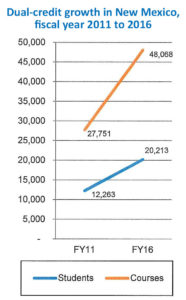New Mexico officials are reconsidering whether increasingly popular college-level classes taken by high school students warrant growing public subsidies.
A report published by the state’s nonpartisan Legislative Finance Committee found dual-credit coursework that can count toward high school and college degrees continues to succeed in helping students make the transition to college or vocational school without stumbling.
It also found, however, that the students who pursue dual-credit coursework tend to have higher academic aptitudes that explain their superior college performance. The finding makes it unclear whether the early collegiate studies warrant annual state spending that has grown to $54 million.
“Taking dual credit courses may have less impact on a student’s ability to obtain a college degree faster and with less remedial coursework than does that student’s general academic aptitude,” said the report, which was presented last week to two panels of lawmakers. “Any savings the state might realize from having students graduate faster are not necessarily a direct function of the state’s $54.4 million annual dual-credit investment.”
Cherry picking?

Source: New Mexico Legislative Finance Committee, “Dual Credit: Funding and Student Outcomes,” Progress Report, September 2017.
The report comes amid growing interest and public investment nationwide in dual-credit coursework as a strategy for getting students interested and exposed to the rigors of college and advanced vocational studies.
Lindsay Daugherty, a policy researcher at the Rand Corporation who is helping Texas evaluate its rapidly expanding dual-credit system, said states are anticipating the immediate benefits of fewer college dropouts and seeking out the long-term returns of a more educated workforce.
“The jury is out on whether there is a good return on investment,” she said. “There certainly are concerns that when you see positive improvements from dual credit, it’s just because you’ve cherry-picked the smartest and most successful.”
A national report on dual enrollment released last week by the Community College Research Center at Columbia University found similar results regarding differences in participating students. It also found academic gaps between students according to family incomes.
Looming changes
In New Mexico, state spending on dual-credit education has increased by at least 60 percent since 2012, as classes shift to college faculty and campuses without any reduction in high school funding, the analysis found. At public colleges, the state’s per-student funding for the classes has fallen.
Dual-credit courses were included in a redesign of high school curricula by the New Mexico legislature in 2013 aimed at challenging students and better preparing them for college and careers.
Currently, state education officials are drafting new quality standards and eligibility requirements. Among the suggestions is a prohibition on taking college-level classes on a pass-fail basis or by audit.
At some dual-credit programs, educators already actively recruit students who might not otherwise have exposure to collegiate academics or advanced vocational training, while limiting enrollment to classes that can count directly toward a degree and certificates.
Patrick Arguelles serves as school principal at the Career Enrichment Center and Early College Academy, where more about 1,500 students arrive from across Albuquerque for one of three daily rounds of college-level coursework.
“For the kids from a lower socio-economic background, it gives them a real taste of what to expect in college,” he said.
Editor’s note: CCDaily reports contributed to this article.

